Exercises (650)
Mobilisation: Spine
Mobilisation of the joints / dynamic stretching
Individual work

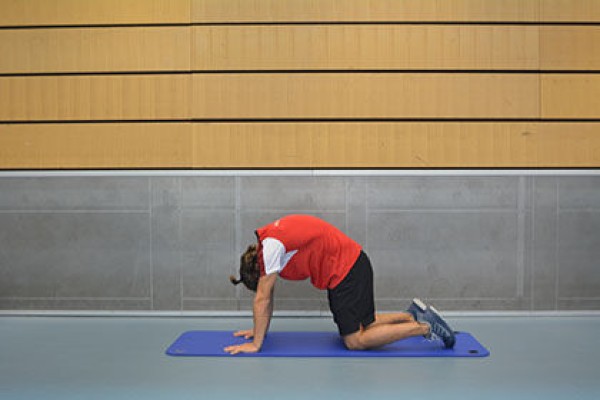
Stand on four feet with your arms stretched out directly below your shoulders, knees/lower legs hip-width apart, alternating between a position with a rounded back ("cat hump") and a position with a hollow back ("cow"). Perform the movement slowly and in a controlled manner until the end of the respective range. As a variation, circular movements can be integrated with the hips.
Cat: Exhale, draw in the belly button, tilt the pelvis backwards, the spine is curved upwards and the chin is pulled towards the chest, the arms push firmly against the floor.
Cow: Inhale, press your belly button towards the floor, tilt your pelvis forwards, your spine is bent towards the floor and your chin is pointing diagonally forwards (stretch your head, tilt backwards), your shoulder blades are pulled together.
No material required
Mobilisation: Spine
Mobilisation of the joints / dynamic stretching
Individual work


Stand with your arms outstretched (possibly including grasping your hands) and holding them high (overhead). Tilt/move the upper body alternately from one side to the other.
Variant:
Exercise can also be performed in a kneeling position.
No material required
Mobilisation: Spine
Mobilisation of the joints / dynamic stretching
Partner work


The partners stand back to back with their legs straddled wide in an upright position, grasp each other's hands with outstretched arms held high (overhead), alternately lean/move the upper body from one side to the other.
Variant:
Exercise can also be performed in a hip-width stance or kneeling position.
No material required
Mobilisation: Spine
Mobilisation of the joints / dynamic stretching
Individual work









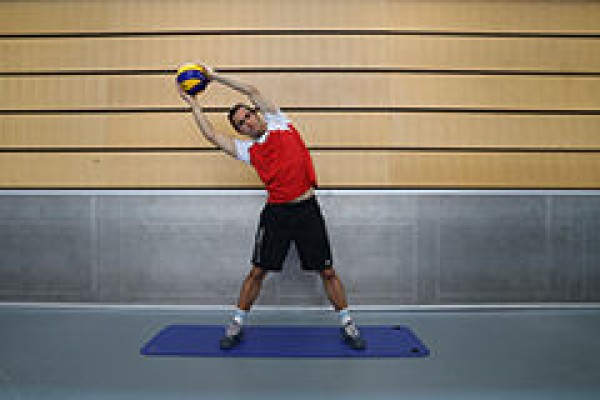
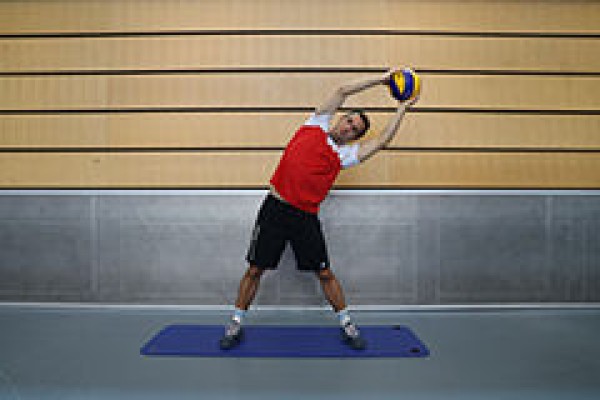
Legs straddled wide in an upright position, outstretched arms held high (overhead), grasp the aid with both hands. Tilt/move the upper body alternately from one side to the other.
Variant:
Exercise can also be performed in a hip-width stance or kneeling position.
Per Tn:
1 ball ►baseball, blitzball/rugby/football, fistball, futsal/football, handball, FooBaSKILL, volleyball
1 stick ► floorball, intercrosse/lacrosse, Nordic walking
1 racket ►badminton/speedminton, smolball
1 throwing disc (frisbee) ►frisbee ultimate
1 elasticated rubber band/power tube/skipping rope/playing rope
1 gymnastics stick with elastic band
Mobilisation: Spine
Mobilisation of the joints / dynamic stretching
Individual work


Legs straddled wide in an upright position with arms outstretched (possibly including hands) and held high (overhead). Tilt/move the upper body alternately from one side to the other.
Variant:
Exercise can also be performed in a hip-width stance or kneeling position.
No material required
Mobilisation: Spine
Mobilisation of the joints / dynamic stretching
Individual work

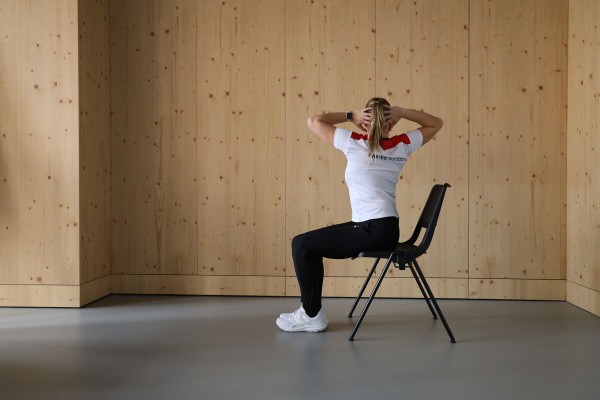
Sitting on a chair with your back straight, cross your arms behind your head. From this position, slowly rotate your upper body from side to side (looking to the left and right respectively).
1 (office) chair
Mobilisation: Spine
Mobilisation of the joints / dynamic stretching
Individual work
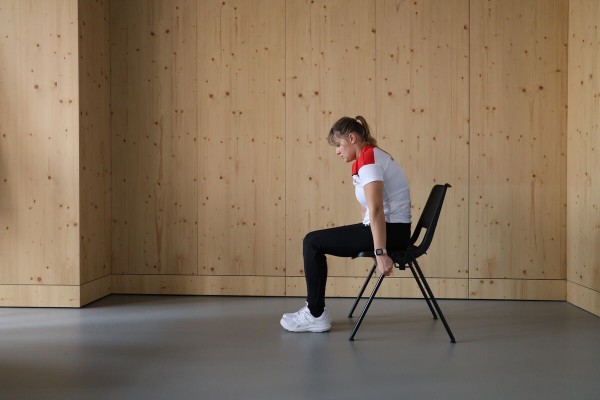
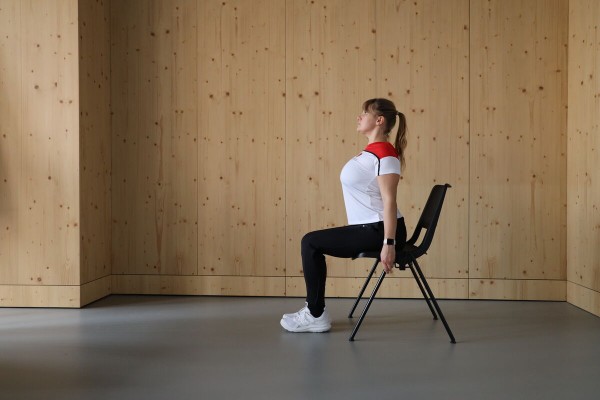
While sitting upright, grip the seat of the chair on each side with your hands. Alternate between a position with a rounded back ("cat hump") and a position with a hollow back ("cow"). Perform the movement slowly and in a controlled manner until the end of each reach.
Cat: Exhale, draw in your belly button, tilt your pelvis backwards, bend your spine upwards, pull your chin towards your chest and push your arms firmly against the seat.
Cow: Inhale, press your belly button towards the floor, tilt your pelvis forwards, your spine is bent towards the floor and your chin is pointing diagonally forwards (stretch your head, tilt backwards), your shoulder blades are pulled together and your arms push firmly against the seat.
1 (office) chair
Mobilisation: spine / shoulders
Mobilisation of the joints / dynamic stretching
Individual work


Legs straddled wide, upper body leaning far forwards. In the swing, alternately bring each hand crosswise to the tip of the foot, with the other hand pointing upwards at the back.
No material required
Mobilisation: spine / shoulders
Mobilisation of the joints / dynamic stretching
Partner work

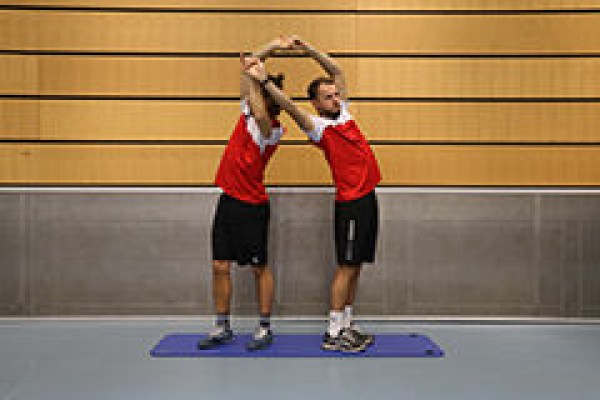

Frontal facing of the partners with mutual grasping of hands. The arms are raised above the heads and the two participants rotate once around their own axis without letting go of each other's hands. The direction of rotation is changed after each execution.
No material required
Mobilisation: spine / shoulders
Mobilisation of the joints / dynamic stretching
Individual work







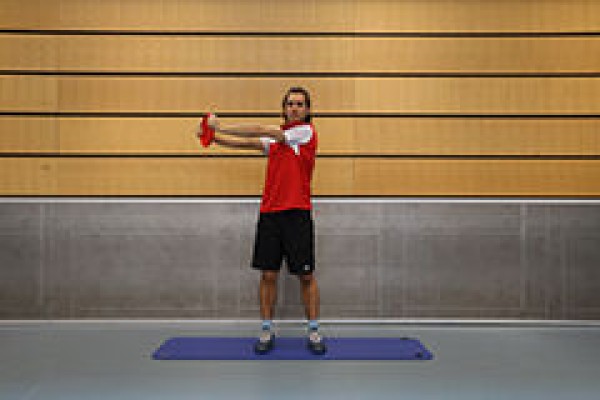


Stand with your arms outstretched in front of you and grasp the aid with both hands. Move/swing your arms from one side to the other at chest height with the largest possible range of motion (arms pointing diagonally backwards).
Variant:
Exercise can also be performed in a kneeling position.
Per Tn:
1 ball ►baseball, blitzball/rugby/football, fistball, futsal/football, handball, FooBaSKILL, volleyball
1 stick ► floorball, intercrosse/lacrosse, Nordic walking
1 racket ►badminton/speedminton, smolball
1 throwing disc (frisbee) ►frisbee ultimate
1 elasticated rubber band/power tube/skipping rope/playing rope
1 gymnastics stick with elastic band
Mobilisation: spine / shoulders
Mobilisation of the joints / dynamic stretching
Individual work


Stand with your arms outstretched in front of you (grasp hands if necessary). Move/swing your arms from one side to the other at chest height with as wide a range of motion as possible (arms pointing diagonally backwards).
Variant:
Exercise can also be performed in a kneeling position.
No material required
Mobilisation: spine / shoulders
Mobilisation of the joints / dynamic stretching
Partner work

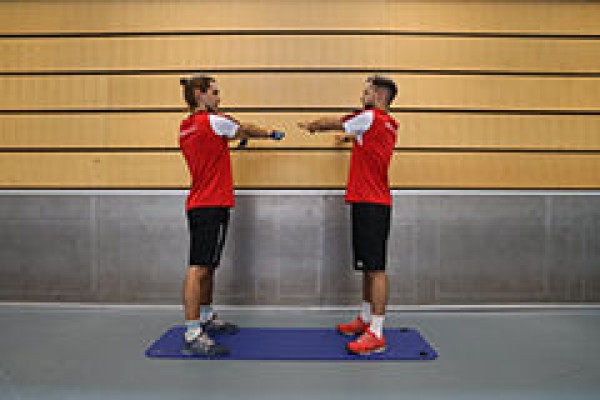









The partners stand hip-width apart with their arms outstretched in front of them. Together, the aid is held slightly less than shoulder-width apart at chest height and moved/swung from one side to the other with the greatest possible range of motion (arms pointing diagonally backwards).
Variant:
The exercise can also be performed in a kneeling position.
Per group of 2:
1 ball ►baseball, blitzball/rugby/football, fistball, futsal/football, handball, FooBaSKILL, volleyball
1 stick ► floorball, intercrosse/lacrosse, Nordic walking
1 racket ►badminton/speedminton, smolball
1 throwing disc (frisbee) ►frisbee ultimate
1 elasticated rubber band/power tube/skipping rope/playing rope
1 gymnastics stick with elastic band
Music cards
Stimulate circulation
Group work
Each participant receives a card with a task and moves freely in the hall/area to the music (study the exercise). The sports leader can specify various forms of movement (crossing legs, circling arms, crouching, touching the floor, hopping, hopping with one leg, etc.). As soon as the music becomes quieter, the card must be placed on the floor and the exercise performed according to the instructions. As soon as the music gets louder again, the participants look for a new card, move freely around the hall/area again and study the next task.
Variant:
This form of the game can be used to form teams by depicting coloured symbols or numbers on the task cards (see sample) and the participants form the teams based on their last task card.
1 music system incl. music (various)
x task cards
Music stop
Stimulate circulation
Group work
Each participant moves freely in the hall/area to the music. The sports leader can specify various forms of movement (crossing legs, circling arms, crouching, touching the floor, hopping, hopping with one leg, etc.). When the music stops, the participants complete a task announced by the sports leader as quickly as possible (until the music starts again):
- 5 jumping jacks
- 4x two-legged jumps over a line
- Greeting a partner in a push-up position
- Touching the top rung of the wall bars
- etc.
1 music system incl. music (various)
Number race
Increase pulse
Group work
4-6 participants per group
All participants in a group are given a number and line up in a column behind the starting marker. On an acoustic signal (e.g. a number called out by the sports leader, number of beats on the tambourine or tapping with sticks), the runners matching the sound (same numbers) compete against each other by running round a turnaround and returning to the starting position. The winning group receives a point (points may be awarded to the winner as well as the second and third place finishers). After a certain number of rounds, the groups are reshuffled so that the same participants do not always compete against each other.
Variant:
Change the form of movement (e.g. one-legged hopping, four-footed gait, running backwards).
Per group:
2 colouring sticks
Depending on signal selection:
1 tambourine
2 drumsticks
Number race in a circle
Increase pulse
Group work
10-20 participants per group
Choops are distributed in a circle in the hall/area (even number and labelled with number sheets) so that one participant can stand in each hoop (number of participants = number of hoops). The two teams line up opposite each other. The tyres opposite each other are given the same number (for two teams). When an acoustic signal is given (e.g. a number is called out by the sports leader, the number of beats on the tambourine or tapping with sticks), the participants with the same number compete against each other. The first person to take the opponent's position wins the round and collects a point for their team. The game leader can decide whether the run has to go through the circle or around the circle (possibly changing the form of locomotion, e.g. one-legged hopping, four-footed gait, running backwards). After a certain number of rounds, the positions within the team are swapped so that the same participants do not always compete against each other. Which team collects more points?
Variant:
Individual competition. Each participant counts the rounds they have won. The positions must be swapped as often as possible (e.g. after each duel, one side swaps positions with its left neighbour and the other with its right neighbour) so that there are many different duels. The disadvantage of this form is that not all participants complete the same number of runs.
Per participant:
1 hoop
x number sheets
Depending on signal selection:
1 tambourine
2 drumsticks
Pair catching
Stimulate circulation
Group work
Groups of 2
Two players form a team. They are connected to each other with a rope, which they wrap once around their wrist (or simply hold the rope) or by holding a stick (Siamese twins). The binomial must never let go of the rope/stick. One pair (labelled with bibs) chases the other pairs. If a pair is caught, the roles (hunter & catcher) are swapped. The game can also be played with several pairs of catchers.
Variant:
Fix the legs of the pairs together with the rope.
Per group of 2:
1 skipping rope/stick ►Intercrosse/lacrosse, floorball, Nordic walking
2-6 game ribbons/leashes ►catcher (variant)
Partner tracking
Increase pulse
Partner work
Groups of 2
Two participants stand, lie, sit or kneel behind each other in a line at a distance of approx. 1-2 metres. The hands are placed on the back. At a signal from the sports leader, the participant in the back tries to catch the participant in front in front of a defined line. The roles are swapped on the next pass.
Possible start signals:
Acoustic:
- Call from the sports leader
- Tambourine
- Start music
Visual:
- Coloured cloths/hats (one colour is the start)
- Sports leader gives a signal (e.g. raise/lower arms).e.g. raise/lower arms, show number of fingers)
According to signal selection:
1 music system with music
2 drumsticks
1 tambourine
4 cloths/caps
Passport stress
Stimulate circulation
Partner work
The pair stand opposite each other (facing their partner). A distance of approx. 3-4 metres is maintained between the binomial. The binomial tries to string together 10 successful passes as quickly as possible. A pass is successful if the throwing disc (the frisbee), the ball (with the playing equipment) is caught or the shuttle (ball) is returned correctly. If a mistake is made (the disc or the ball/shuttle falls to the ground), the count starts again. The distance can be varied as desired after a successful attempt.
Variant I:
Multiple groups of 2 compete against each other (2 rows). The winning binomial is the one that is the first to string together 10 successful passes after the sports director's start signal. After each pass, the distance is increased (one row moves back 1-2 steps).
Variant II:
The sports leader specifies a throwing/striking/passing technique, provided that the individual techniques have already been practised.
Per participant:
1 bat/stick ► Intercrosse/Lacrosse, Smolball, Floorball, Badminton/Speedminton
Per group of 2:
1 disc (Frisbee)/ball/shuttle ► Frisbee Ultimate, Basketball, Blitzball/Rugby/Football, FooBaSKILL, Futsal/Football, Handball, Intercrosse/Lacrosse, Smolball, Floorball, Volleyball, Badminton/Speedminton
Fits
Stimulate circulation
Group work
4-6 participants per group
All participants move freely in the hall/area. Within the group, the participants pass a ball/throwing disc to each other. The sports leader can specify types of pass (e.g. ground pass, high pass, inside and outside instep, backhand, forehand, etc.) and throwing disc/ball receptions (e.g. one/two-handed catching, receiving with the sole of the foot, etc.). The exercise is then rearranged so that one group (e.g. blue) plays the ball/throwing disc to the other group (e.g. red) and in turn receives the ball/throwing disc from another group (e.g. green). The sports leader can integrate additional balls/throwing discs into the exercise.
Variant:
If the sports leader calls out the colour of a group with the addition "column" (e.g. "blue column"), the called group lines up in a row facing the back of the person in front (distance between the participants approx. 1-2 metres). Next, the sports leader calls a command for another group (e.g. command "red slalom"), which performs a movement task with the ball/throwing disc around the group lined up in column (e.g. bouncing the ball, guiding the ball with the feet or balancing the ball on a piece of equipment). The participant who has passed the slalom then passes the ball back to the next group member (e.g. past the lined-up group or between the spread legs). Once all group members have completed the slalom, all participants move freely around the hall/area again.
Per participant:
1 stick/stick ►intercrosse/lacrosse, smolball, floorball
1 wristband/stick ►team identification
Per group:
1 ball/throwing disc (Frisbee) ►Basketball, Frisbee Ultimate, FooBaSKILL, Futsal/Football, Handball, Intercrosse/Lacrosse, Smolball, Tchoukball, Floorball
Sports leader:
x additional balls/throwing discs (optional)
Fits
Stimulate circulation
Partner work
Two participants stand opposite each other and pass the ball/throwing disc to each other. The distances, types of pass (e.g. ground pass, high pass, inside and outside instep, backhand, forehand, overhead throw, etc.) and throwing disc/ball reception (e.g. one/two-handed catch, reception with the sole of the foot, sandwich catch, etc.) are varied. After the static form, the participants move freely around the hall/area and pass the ball/throwing disc to each other while moving.
It is important to ensure that the exercise is performed with both the stronger and weaker hand (ditto foot).
Variant I:
Include challenging trick throws/shots.
Variant II:
The two participants each throw/pass a ball/disc (frisbee) to their partner at the same time, whereby it should be agreed who throws/passes their ball/disc at which height/side.
Per participant:
1 stick/stick ►intercrosse/lacrosse, smolball, floorball
Per group:
1 ball/throwing disc ►basketball, Frisbee Ultimate, FooBaSKILL, futsal/football, handball, intercrosse/lacrosse, smolball, tchoukball, floorball
1 additional ball/throwing disc (Frisbee) ►variant
Fits
Stimulate circulation
Partner work
Two participants face each other and pass the ball/shuttle to each other. The distances and types of pass (e.g. high pass, backhand, forehand, etc.) are varied.
The exercise can be performed with either the stronger or weaker hand.
Per participant:
1 racket ►smolball, badminton/speedminton
Per group of 2:
1 ball/shuttle ►smolball, badminton/speedminton
Horse racing
Increase pulse
Group work
4-6 participants per group
The person in front of the group has a rope around their torso, which the person behind them holds with their hands. The person behind stands on two pieces of carpet. Now the participant is led around the painting stick and back on the carpet remnants by the partner (the horse). The participant who was standing on the carpet remnants becomes the "horse" for the next participant in the group on the next pass (in the last changeover, the starting runner still has to be led around the turnaround).
The changeover takes place when the carriage team behind the waiting group returns to the starting position to swap roles. The form can be performed as a competition or as an exercise (for safety reasons, it may be necessary to perform the game form, as the dangerous turns are performed more slowly this way).
Per group:
1 skipping rope
1-2 carpet remnants
2 colouring sticks
Reaction ball
Increase pulse
Group work
Groups of 2
The person behind passes the ball (by hand or foot) between the legs of the person in front, who must react and stop the ball before a certain line.
Variant:
Vary the starting position of the person in front (e.g. kneeling, passing the ball on the side or lying down, lifting the ball over the body).
Per group:
1 ball (football, volleyball, basketball, smolball or handball)
Reaction ball
Increase pulse
Group work
Groups of 2
The person behind plays the ball between the legs of the person in front, who must react and stop the ball in front of a certain line.
Variant:
Vary the starting position of the person in front (e.g. kneeling, passing the ball to the side or lying down, lifting the ball over the body).
Pro Gruppe:
1 Intercross-/Unihockeyball
Pro Tn:
1 Intercross-/Unihockey-Stock